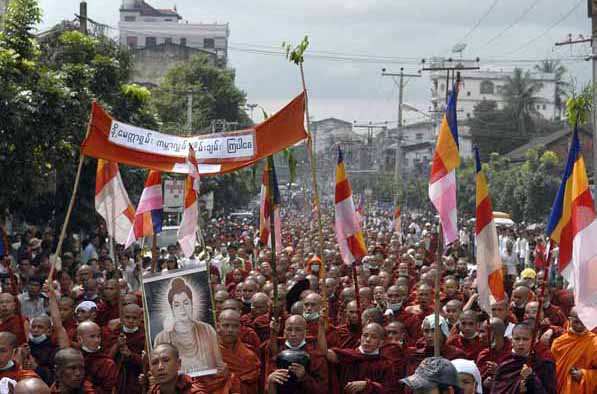Can the Opposition Remain Relevant?

Since 1988, the dominant forms of struggle employed by the opposition groups have been political parties (mainly the NLD), underground/clandestine movements, civil society organizations, armed insurgencies and international advocacy movements.
Due to the cease-fire agreements between the junta and the ethnic resistance groups since 1989, the armed insurgencies have mostly been contained. However, international advocacy movements have been strong thanks to the political-moral strength of Daw Aung San Suu Kyi and the increasingly large Burmese diaspora communities around the world.
.jpg) |
| Student protest in Rangoon during the 1988 mass uprising.(Photo: THE IRRAWADDY) |
Another element of Burmese opposition resilience is its mobilizing structure, which is in many cases hierarchical. However, whenever Suu Kyi was free, she traveled to provinces where she empowered and inspired local and grass-roots party members to mobilize. In fact, she sparked initiatives of civil society by encouraging youth and women leaders to set up volunteer groups on wide-ranging issues such as assisting HIV/AIDS patients and providing legal protection for child soldiers and the victims of forced labor.
In addition, when Min Ko Naing and other 88 generation student leaders were released from prison in 2004-05, they broadened the opposition’s civil society practice within its nonviolent repertoire by reaching out to Buddhist monks, human rights advocates, lawyers, journalists, local NGOs, intellectuals, writers, the artistic community and others to strengthen the informal connective tissue of the movement. Before the activists had sufficient time to organize, however, the 2007 protests broke out. Though their initiatives contributed to the emergence of the “Saffron Revolution” in 2007, their lack of leverage allowed the regime to crush the movement in a violent crackdown.
Leverage
Although leverage is not the ultimate outcome sought by the opposition, improved leverage is, like resilience, a positive outcome that can be a stepping stone to achieve the desired endgame of regime change or even a negotiated outcome.
Since 1988, Burma’s activists have relied to a large degree on marches, protest demonstrations and public statements making political demands or requests. As social scientist Kurt Schock notes, these methods may be effective in mobilizing members of the aggrieved population and the support of third parties, and thereby obtaining legitimacy, but they are less effective in directly undermining state power to achieve desired outcomes unless used in tandem with methods of non-cooperation.
This lack of tactical innovation by the opposition has been compounded by the fact that the social groups most prominent in the movement—students and Buddhist monks—while providing maximum symbolic value, provide weaker leverage than workers or peasants because the state is less dependent on students and monks to maintain its power and survive. Thus far, no organization has emerged in Burma that is capable of effectively forging ties between students, monks, workers and peasants.
The opposition should also take into account the crucial role a third party can play in improving opposition leverage. For example, China’s current diplomatic support and political protection of the junta in the international arena, as well as its economic and military support, are one of the most challenging constraints on the opposition movement.
« previous 1 | 2 | 3 next page »
